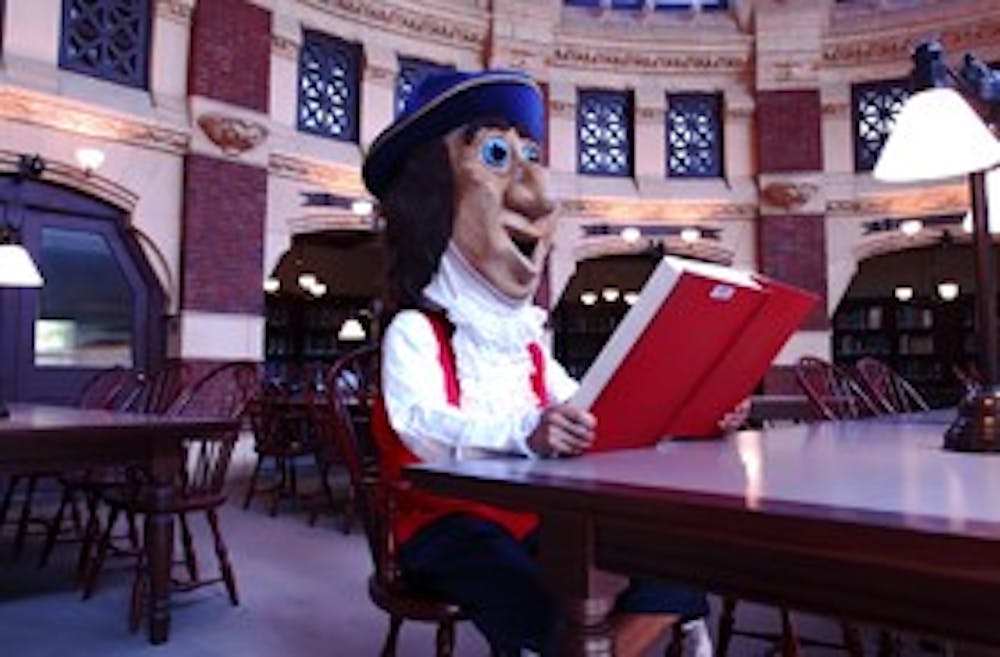Ask a Penn student about the connection between the Quakers and the University, and the reply will likely allude to the contradiction inherent in the “Fighting Quakers.” Many students — and even faculty members — go through years at Penn without realizing that the University is, in fact, not a Quaker institution, nor did it ever have any religious ties to Quakerism.
“Students who see that our mascot is a Quaker probably just assume that there must be some sort of historical connection,” said College junior Jessica Heidenberg, who was a Quaker mascot her freshman year.
The idea that Quakerism is deeply rooted in Penn history, though, is a common misunderstanding, according to University Archives Director Mark Frazier Lloyd. It is precisely that balance — of reconciling a school whose surface symbol is a Quaker yet has no real roots to the faith — that poses an interesting challenge.
Claim to Fame
According to Lloyd, the nickname “Penn Quakers” was actually born through sports writing in Philadelphia in the 1880s and 1890s — just as the title “Ivy League” has its origins in New York sports writing half a century later.
Philly was known as the “Quaker city,” so “it was natural for sports writers to call the Penn athletic teams the Quakers,” Lloyd explained.
From its founding in 1740 by Benjamin Franklin — who was raised by staunchly Puritan parents and later adopted the Enlightenment beliefs of Deism — Penn did not see more Quaker students than other universities. The University’s first provost, William Smith, was not a Quaker, but rather an Anglican minister. Even after Penn gained its Quaker moniker, the fact did not influence the University’s ability to attract students, faculty or trustees of Quaker faith, Lloyd said.
Although it is difficult to determine the number of Quakers that attended Penn in the past, the University’s location in Pennsylvania, the geographic core of the Quaker faith, may have attracted more student believers, according to University Chaplain Chaz Howard.
Though Quakerism — also known as the Religious Society of Friends — began in England in the 1650s, it was not until William Penn founded Pennsylvania in 1681 as a safe haven for Friends to practice their faith that the religion established foundations in the U.S.
“The only thing that’s interesting about ‘Penn Quakers’ as a term is that it has stuck to the University of Pennsylvania,” said Lloyd, who added that over the years the name stayed as a result of the school’s high-profile athletic teams.
“It reveals that for many years, Penn was a big-time competitor in intercollegiate athletics,” said Lloyd, who pointed to the building of Franklin Field and the Palestra in the 1920s as evidence.
That high-profile athletics are a fundamental part of Penn history is a fact that most students today don’t know about, according to Lloyd. From 1890 to 1952, Penn was a major powerhouse in intercollegiate sports.
Yet despite the loss in athletic reputation, the University’s shift toward academics with the creation of the Ivy League as more than just a sports league is what allows it to be consistently ranked in the top 10 schools in the natio academically today. Lloyd said this “would not have happened if we had continued to pour resources into athletics” — in other words, if the Quaker mascot were as famous as Penn’s scholastic reputation.
A Gentlemen’s Agreement
Though Penn does not have religious roots in Quakerism, the Quaker values may have a deeper presence at the university than a casual survey might suggest, in part due to the school’s historic location in Philadelphia.
“Penn has reaped some of the fruits of early Quakerism’s colonial history — abolition, anti-poverty, women’s rights,” Howard said.
Beyond that basic level of connection, Howard also pointed out the strong echo on campus to the Quaker commitment to social justice. “Various spaces in our University really demonstrate work toward justice — obviously the Law School, but also stuff in SP2 and even in the Med School and certainly several courses in the College and School of Nursing,” Howard said.
One concrete legacy is the Quaker Consortium, a collaboration between Penn, Bryn Mawr, Haverford and Swarthmore colleges. Like the Quaker mascot, however, the Quaker reference may have little underlying meaning.
According to Associate Dean and Director of Academic Affairs Kent Peterman, the Consortium harks back to a 1934 “gentlemen’s agreement” in which “no money changed hands” — a “Quaker” arrangement, if you will.
Yet the actual pact owes more to the schools’ proximity, high-caliber students and to the idea of expanding students’ academic options, than to any religious principles. In fact, no formal reference of the “Quaker Consortium” exists, according to Peterman, and nowhere on the original document is the word “Quaker” used as identification — the Consortium is simply referred to as a “reciprocal program.”
Outside of academics, another question surrounds the role that Quakerism’s religious and moral facets play in attracting students to Penn.
“Maybe some students think about the Quaker heritage in the area — my hunch is that there exists the largest concentration of Quaker meetinghouses in the area — but only in the same way that people would want to study in Philadelphia because of its urban environment,” said Howard.
Read part two of the history of Penn and Quakerism on Friday for more answers on the meaning behind the name.



